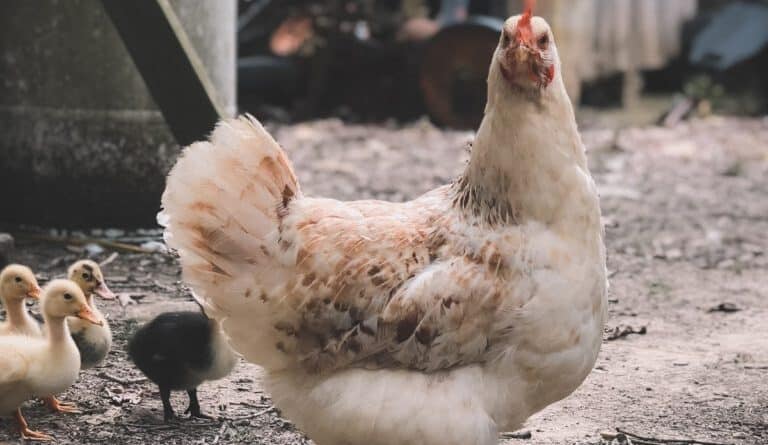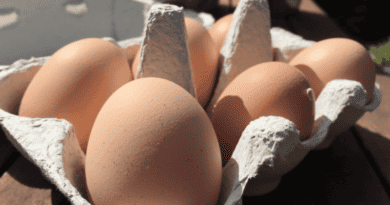Top Chicken Toys: Enhancing Your Pet Chickens’ Happiness and Health
Keeping your feathered friends entertained and healthy is essential for any chicken keeper. Here are six innovative toys that can enrich the lives of your pet chickens, based on current trends and recommendations:
- Chicken Treat Ball – A simple yet effective toy, the chicken treat ball allows you to fill it with berries, grains, and mealworms, providing both a physical and mental challenge as chickens work to access the treats. Its design is easy to fill and clean but is best suited for smaller treats.
- Vehomy Wood Mirror Toy with Bell – This toy combines a mirror with a bell, offering visual stimulation and the intrigue of their own reflection, alongside auditory stimulation from the bell. It’s designed to be safe, with a sturdy wood frame and shatter-resistant mirrors, making it an engaging addition to any coop.
- Chicken Swing – Swings aren’t just for kids; chickens enjoy them too! Introducing a swing to your coop can provide hours of entertainment. Starting chicks young on the swing can help ensure they continue to enjoy it into adulthood. It’s a fantastic way to keep your chickens active and entertained, especially during the colder months.
- Lixit Chicken Toy – This roll-around toy can be filled with your chickens’ favourite treats, encouraging natural foraging behaviour as they work to dispense the treats. It’s an engaging toy that promotes physical activity and can keep multiple chickens entertained at once, reducing competition for food.
- Chicken Playground with Treat Basket – For those willing to invest a bit more, a chicken playground equipped with swings, ladders, and a treat basket can simulate natural foraging behaviour and provide endless entertainment. It’s particularly suited for larger flocks and can be a focal point in your backyard.
- DIY Dust Bath – While not a “toy” in the traditional sense, a dust bath is an essential feature for chicken health and entertainment. Using simple materials like tyres or kiddie pools filled with sand or diatomaceous earth, you can create a fun and functional spot for your chickens to bathe, which helps them maintain feather health and prevents parasites.
Each of these toys offers a unique way to engage your chickens, promoting healthy physical and mental activity. Whether you choose to buy or DIY, the key is to provide a variety of stimulating activities that cater to the natural behaviours and preferences of your flock.
Best Chicken Waterer – A buyers guide
Your chickens need a secure supply of water that is always waiting for them a chicken waterer will help you with that. This will make sure you have healthy, and productive, chickens. Chickens supply both eggs and quality meat.
There are many types of chicken waterer to suit all needs and is one of the essential tools you need. You need to make the right choice for the best chicken waterer for the needs of your flock, one that will be both within your budget and will serve you best.
Here are some of the best we found.
Oasis Chicken Watering Cups
This 4-pack of cups is fully automatic. Your backyard chickens do not need to peck at a tab or float. The cups are nearly 3″ in diameter and the pack includes both instructions and fittings. They even include a drill bit. The product is manufactured by Backyard Flock.
Little Giant Galvanized Double Wall Founts
This waterer is both convenient and highly durable. It retains a constant water level and the top is sloped to discourage your birds from roosting. The unit has a two-gallon capacity. There is an optional heater base for winter use and this is sold separately.
Amazon has a ton of options for you to choose from. The heated option will cost you about 50 $, and there are some good cheap options as well. See the hitlist of chicken waterer at Amazon here… (nor an affiliate link)
Backyard Barnyard Vertical
This 4-pack uses a float regulator to maintain water levels. So there is no training for your chickens on how to get water. The water is always there. There is always a full cup every time it is needed. It is recommended that you allow one cup for every 4-6 chickens, so this pack will cover up to 24 birds. These cups are suitable for mounting underneath a hanging bucket.
They can easily be cleaned by spraying them using a hosepipe.
Premier Heated Poultry Waterer
No icing-up with this waterer. This 3-gallon container with a secured lid is sloped so that birds cannot perch on top. The lid is insulated to reduce heating costs. It is a large unit and can cope with up to 35 birds. It comes complete with a 16′ grounded power cable, which can be detached during the warmer months.
The heater is controlled by a thermostat which makes the heating element kick in when temperatures drop to 40 and turn off at 46. It consumes 100 watts. This model has drip catch nipples, and the unit should be hung so that the nipples are just slightly higher than the bird’s heads.
Key Considerations when making your choice of chicken waterer
- How many birds do you have?
- Standard, Bantam, or chicks?
- Are they all in one coop?
Birds will drink about a pint each day. If the weather gets hot then you can double that, so you need a waterer with sufficient capacity for the entire flock for one day of sunshine, or you will be running to and fro refilling your waterer and food.
I hope that we have helped in your search for the best chicken waterer.
A waterer is just one of the essentials you’ll need in you coop. If you want to know if you have got everything, you can check out our essential tools list here…
How Do Chickens Lay Eggs?
Some say that the egg is just as incredible as it is edible, but we owe the wonder of eggs to the wonders of chickens. Chickens are incredible animals for their relative ease of maintenance and amusing personalities that simultaneously yield a bounty of fresh eggs. As wonderful as chickens are, they aren’t immune to problems. One of the responsibilities of being a successful chicken owner is knowing how to take care of your chicken. If you’ve ever wondered how do I know if my chicken is in pain, you’ll find information below that will help you to better understand your chicken’s natural egg-laying habits as well as how to help your chicken if it’s ever feeling less than stellar.
How Many Eggs Do Chickens Lay Naturally
The modern chicken has been carefully bred to specifically produce as many eggs as possible. The ancestors of the modern chicken, wild jungle fowl, will typically only lay 10-15 eggs a year. Given modern breeding, hens can lay anywhere from 200-300 eggs in a year depending on the breed, diet and how old the chicken is. There are periods of the year, specifically winter and when the chicken is moulting, where hens may not lay eggs at all or lay eggs with less frequency. Likewise, if your hen is stressed, ill or infected with a parasite, egg-laying will also be affected.
When Do Chickens Start Laying Eggs
Chickens start laying eggs when they are 18 weeks of age. Once again, this varies based on the breed, the environmental circumstances (temperature, daylight) and the health of your chicken. To ensure adequate egg-laying, it’s recommended to feed your chicken feed with a higher protein content during their egg-laying period.
What Time Of Day Do Chickens Lay Eggs
Your chicken is a light-sensitive creature and daylight will affect many aspects of your chicken’s habits, including when it lays its eggs. Generally, chickens prefer to lay eggs during the morning, or at least the first 6 hours of the day. Once again, laying habits can vary based on the breed as well as any other deviations in diet, season or environment, but when there is sufficient daylight, you’ll probably find an egg in the morning.
How Do Chickens Lay Eggs Every Day
Part of a chicken’s “wild” instinct is to lay eggs that they incubate to hopefully hatch into chicks. This wild tendency is known as laying a clutch of eggs, or approximately 10-12 eggs that a hen will sit on so they can hatch. If you harvest eggs daily, then your chicken will be unable to lay enough eggs to reach the clutch stage and will continue to lay eggs, thinking that she will eventually reach this stage. This is why it’s important to harvest your chicken’s eggs daily so that you can prevent your chicken from attempting to brood and raise her eggs prematurely (though you probably will encounter a broody hen regardless).
Why Does A Chicken Lay Unfertilized Eggs?
Critical to the egg-laying process is whether the eggs are fertilized or unfertilized. A fertilized egg is an egg that has been fertilized with sperm that can then potentially develop into a viable chicken. Unfertilized eggs have not been exposed to sperm and therefore will be unable to develop into a chick, even if a hen or you incubate the eggs. If you want fertilized eggs, then you will need a rooster to service your hens. Even if you have a rooster, fertilized eggs will only develop into chickens if a hen lays on the eggs for at least 3 weeks or if the eggs are properly incubated. If you want to keep your eggs unfertilized or keep potentially fertilized eggs from developing into embryos and chicks, avoiding roosters and broody hens while keeping your eggs chilled will prevent development.
How Do Chickens Lay Eggs
The egg-laying process is an incredibly fascinating aspect of your chicken’s life. Similar to other animals, when a chicken is born it contains all of the ovaries it can deposit in its lifetime. Eggs start out as immature yolks; when a hen reaches egg-laying maturity, every 24 hours one of these yolks is mature enough to then become an egg. It enters the chicken’s oviduct where, if the hen has encountered a rooster, it would then become fertilized.
With or without the rooster, the egg will continue through the oviduct and gain the layers of egg white, which serve as nourishment for a developing embryo, as well as bloom, a cuticle that protects the embryo as it’s developing from any intruding pathogens. At the end of the oviduct is the shell gland which coats the egg in its typical hard shell and which pushes the egg through the cloaca, the opening in the chicken were eggs and faeces exit, and towards the chicken’s vent that releases the egg. Given the shape and positioning of the shell gland, it effectively seals the chicken’s intestinal tract while a chicken is laying eggs, ensuring that only a sanitary egg emerges from your chicken.
Chicken Coop Defense: How to avoid pests in your chicken house
Today more and more people are interested in owning chickens. From completely GMO and cruelty-free eggs to even having some educational values for your children and family.
Chickens are becoming more of a staple to people who have a room in the garden or backyard. With all these bonuses there are also some downsides. Chicken house pests can be a real pain. Below is our ‘how to’ for dealing with those pests.
Rats and Mice
Rats and mice can be some of the worst pests to get, not just for a chicken coop but also for just your house. Placing traps and the conventional methods of defence from these common pests will usually work. Make sure you close up any potential holes or loose boards in the house. Make sure that they don’t have easy access to the chickens’ food as well. Covering the food with strong metal containers will help prevent them. If all else fails, call a professional!
Chicken Mites
Chicken Mites can just be gross. They are also one of the most common pests found in your chicken coop. Chicken mites, as well as numerous other parasites, can be defended against with a relatively simple and old technique. Setting up a dust bath can help prevent numerous parasites, and generally avoid pests in your chicken house. It only requires some simple soil and sand.
Flies
Flies can be just plain out gross. They linger around, bothering both you and your chickens, and can even spread diseases! One of the best natural recipes we suggest for dealing with it is to plant mint plants around the coop. These will provide a nice decoration as well as the function of scaring away those pesky flies. Another more conventional method would be to just use fly traps! They work well and hanging them around the coop can help.
Flytraps are conveniently available on Amazon. You have a lot of options and they’re cheap too. Check out the current prizes here… (not an affiliate link)
It can be simple
In the end, some of the best strategies are often the most common – and for good reason. Defending from chicken house pets can be even very simple at times. One of the main things that we recommend for both chicken health and to defend from the pests is to be diligent in cleaning the coop. A lot of these pest issues start from unclean coops.
Making sure you also keep a close eye on them and watch for pests in the coop early makes it easier to take action faster. Taking steps to protect your chickens that help them feel better is great because they will produce tastier and healthier eggs!
What To Feed Chickens
Looking to have farm fresh eggs at your fingertips? Raising backyard chickens will do just that. Although they may be a bit of work up front, once a coop is built, chickens are relatively easy animals to keep. Plus they have the added benefit of producing those tasty eggs to use for breakfast every day.
Benefits of Raising Chickens
Obviously, the best reason for getting chickens is their eggs. There is nothing like a fresh egg. You’ll find that they taste better than store-bought and once you try one, you’ll never go back.
Besides the tasty eggs, chickens are also great about pest control. They’ll eat your ticks, beetles and worms. If that’s not reason enough, I don’t know what is.
Having chickens also teaches children about where food comes from. Kids can watch them grow up from baby chicks to hens. They can watch the hens lay eggs, it’ll teach them that our food doesn’t just come from the grocery store.
What to Feed Chickens
Now that you have the chickens, what are you going to feed them? While chickens will pretty much eat any kind of pesty bug around, they’ll also depend on you for additional nutrients, especially during the colder months. Hens that are laying eggs need chicken feed that has plenty of protein and calcium in it. This feed can come in pellet or crumble form. Serving up some apples or berries would make for a delicious treat for your flock. Be aware though, not all fruits and vegetables are good for them; citrus fruits, avocado and uncooked beans can be poisonous to the chickens.
It’s also common for chickens to be fed table scraps but you need to be aware of how much they’re eating. Just like humans, chickens need moderation in order to stay at a healthy weight. It also should be noted that strong flavours such as garlic and onions may affect the taste of the eggs they’re laying.
A hen’s diet also affects the quality and nutrition of its egg. A diet rich in protein and calcium along with fruits and vegetables will make for higher quality and better-tasting eggs.
Not only will chickens keep you entertained with their antics but they’ll provide your family with fresh eggs on a daily basis that tastes great. What to feed chickens is made much easier when you break it down into bugs, chicken feed and additional fruits and vegetables. Keep your flock healthy and they’ll make you just as happy!
Best Chicken Toys On The Market
Chicken love to scratch and peck this all the time to keep themselves busy. If they don’t find things to scratch the chicken, then start pecking each other and pulling each other’s features which would result in the chicken injuring each other.
These problems are common, especially with the backyard chicken since they are confined in a closed area. To prevent this, you can provide the chicken with toys. Some of the best chicken toys include:
Interactive treat dispenser
This type of dispenser can be made using either a plastic container or a soda bottle. You drill holes on the side of the container and fill the container with chicken feeds.
Ensure you remove all the loose plastic particles to avoid ingestion by chooks.
Shredded newspaper
Compost piles
Chicken like to be busy. If you provide a compost pile, they will scratch to use, arch for worms and buds. In the process, they will mix the compost pile and even turn it over.
Old CDs
Chickens are excited by color; therefore, by providing broken CDs to them, it will help in distracting them and keeping them busy.
Old tree branch
Place the old branch to the open so that bugs and other crawling animals for habitats in the branch. Then place the branch at the backyard for the chicken to seek treats from it.
Rope swing
You can also build a swing for the chicken by cutting two rope and a tree branch to form a swing. The swing helps to keep the chicken on their roosts and also in their exercising.
Tunnel
You can also use containers to make a tunnel by cutting one end of the container. This allows the chick to run through the tunnel.
Dust bath
Chicken use the dust to clean themselves and also use it as a ground for socializing and playing with each other.
Chick-N veggie ball
This type of toy allows one to hang cabbage or lettuce off the ground. Then chicken can quickly peck the veggies as food or for entertainment. It also encourages the chicken to eat more since it helps to keep the veggie clean.
Perching places
You can create a perching place by putting together a few tree branches, you may put them at a different level in relation to height. This helps the chicken in exercising and keeping roost.
Pet bird toys
Like the old CDs, the bird toys are used to stir up the curiosity of the chicken. This pet bird toy is more suitable for the chicks.
This article is written by our friends over at backyardchickenscoop.com



